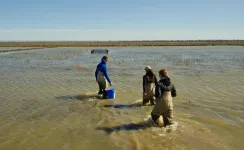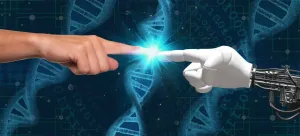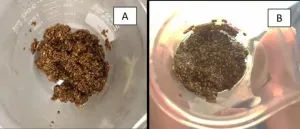(Press-News.org) If you look deep into the eyes of a fish, it will tell you its life story.
Scientists from the University of California, Davis, demonstrate that they can use stable isotopic analysis of the eye lenses of freshwater fish -- including threatened and endangered salmon -- to reveal a fish's life history and what it ate along the way.
They conducted their study, published today in the journal Methods in Ecology and Evolution, through field-based experiments in California's Central Valley. The study carries implications for managing floodplains, fish and natural resources; prioritizing habitat restoration efforts; and understanding how landscape disturbances impact fish.
The technique had previously been used in marine environments, but this is its first use for freshwater fish, many of which are threatened or endangered in California. Lead author Miranda Bell Tilcock, an assistant specialist with the UC Davis Center for Watershed Sciences, helped pioneer the technique for freshwater fish.
"Even the nerdiest fish biologists say, 'You can do what with fish eyes?'" said co-author and team co-lead Rachel Johnson, a research fisheries biologist with NOAA Fisheries' Southwest Fisheries Science Center and associate with the UC Davis Center for Watershed Sciences. "This is an exciting new tool we can use to measure the value of different habitats and focus conservation work."
THE EYES HAVE IT
Much like tree rings, fish eyeballs are archival. The lenses grow in layers throughout a fish's life, recording as chemical signatures the habitats used while each layer was forming and locking in the dietary value of what the fish ate in each habitat.
"It's like a little diet journal the fish keeps for us, which is really nice," Tilcock said.
To uncover that history, researchers perform what Tilcock said is "like peeling the world's tiniest onion." With fine-tipped forceps, they remove layer after layer, revealing a veritable Russian nesting doll of eye lenses. At the end is a tiny ball, like what you'd find in a silica packet, that can shatter like glass. This is the core, where the fish's eyes first began to develop.
Relative to other archival tissue, fish eyeballs are especially rich in protein. The isotopic values in the food webs bind to protein in the eye, leaving tell-tale geochemical fingerprints that isotopic analysis can uncover.
HABITAT IN THE EYES OF THE BEHOLDER
The first field-based experiments using the technique for freshwater fish took place on the Yolo Bypass of California's Central Valley. Here, fall-run, juvenile chinook salmon grew in three distinct food webs: river, floodplain and hatchery.
Scientists then conducted stable isotope analyses on the eye lenses of an adult salmon to reveal its diet history from birth to death. Stable isotopes are forms of atoms that don't decay into other elements and are incorporated into a fish's tissue through its diet. They can be used to trace origins, food webs and migratory patterns of species.
Taking the premise of "you are what you eat," the study's authors looked at the chemical crumbs of carbon, nitrogen and sulfur values in the eye lenses to determine which food webs and habitats the fish used at various life stages.
They found that fish on the floodplain grew quickly and appeared to grow additional laminae, or layers of lenses, during the 39-day study compared to fish reared in the river or hatchery. Also, the Yolo Bypass is home to rice fields, which decompose to add unique sulfur and carbon values -- a strong clue for researchers tracing which habitats fish use.
"This tool is not just unique to salmon in the Central Valley," Tilcock said. "There are many migratory species all over the world that need freshwater habitat. If you can isolate their habitat and value for diet, you can quantify it for long-term success."
For example, co-author and team co-leader Carson Jeffres, field and lab director at UC Davis' Center for Watershed Science, used the technique recently on fish in Brazil to look at changes in the food web there following a dam's construction.
EYES AND EARS WORK TOGETHER
Tilcock, Johnson and Jeffres are part of an "Eyes and Ears" project at UC Davis funded by the California Department of Fish and Wildlife. The project studies fish life history through eye lenses and otoliths, which are found within a fish's ears.
"You use the otolith to trace the river or hatchery where a fish was born based on the unique geology and water chemistry of the tributaries in the San Francisco Bay watershed," Johnson said. "Then you have the eye lens, which tells you where it's eating to help identify floodplain habitats."
"They really work together to present a fuller picture of how salmon move and what they eat as they use different mosaics of habitats across the landscape over their lifetime" said Jeffres. "Now we have the tool we have been looking for to link juvenile floodplain benefits across the salmon life cycle to adulthood. It's the holy grail of measuring restoration success."
INFORMATION:
Additional study co-authors include Andrew Rypel and George Whitman of UC Davis, Ted Sommer of the California Department of Water Resources, and Jacob Katz of CalTrout.
The study was funded by the California Department of Water Resources.
Worldwide, over one billion people live with a disability. Historically, they have been discriminated against and stigmatized by society. To improve their rights, they should be included in political decision-making, yet there is a lack of political representatives who are known to have a disability. This under-representation may be due to several factors, including how voters perceive a political candidate with a disability. However, a new study published in Frontiers in Political Science, found for the first time that voters do not apply negative stereotypes when evaluating candidates with a disability. Rather, voters tend to perceive candidates with a disability as capable, ...
Prescription drug prices in the United States are significantly higher than in other nations, with prices in the U.S. averaging 2.56 times those seen in 32 other nations, according to a new RAND Corporation report.
The gap between prices in the U.S. and other countries is even larger for brand-named drugs, with U.S. prices averaging 3.44 times those in comparison nations.
The RAND study found that prices for unbranded generic drugs -- which account for 84% of drugs sold in the U.S. by volume but only 12% of U.S. spending -- are slightly lower in the U.S. than in most other nations.
"Brand-name drugs are the primary driver of the higher prescription drug prices in the U.S.," said Andrew Mulcahy, lead author of the study and a senior health policy researcher at RAND, a ...
SINGAPORE, 28 January 2021 - One in three adults, particularly women, younger adults, and those of lower socioeconomic status, are experiencing psychological distress related to COVID-19, researchers at Duke-NUS Medical School, Singapore, reported in the journal PLOS ONE.
COVID-19 continues to pose serious threats to public health across the globe, and interventions such as lockdowns, quarantine and social distancing are having an adverse impact on the mental well-being of populations. The pandemic has escalated the burden of psychological distress, including anxiety, depression, post-traumatic stress and insomnia. However, the factors associated with increased susceptibility to psychological distress among adults in the general population during COVID-19 ...
Results of study by Children's Hospital Colorado, presented at the Society for Maternal Fetal Medicine's Annual Meeting, show a third of patients not needing narcotic pain pills after c-section
Aurora, Colo. (Jan. 28, 2021) In a retrospective analysis of cesarean deliveries from 2015 through 2020, a team of doctors from the Colorado Fetal Care Center at Children's Hospital Colorado (Children's Colorado) found that using a wound infusion pump in combination with enhanced recovery efforts such as removing urinary catheters earlier and walking around the same day of surgery can reduce opioid use by more than 80%. Also notable, ...
Researchers from Western University, Indiana University, and Washington State University published a new paper in the Journal of Marketing that uses the idea of psychological distance as a way to leverage qualities of existing consumer-brand relationships.
The study, forthcoming in the Journal of Marketing, is titled "They're Just Not That Into You: How to Leverage Existing Consumer-Brand Relationships through Social Psychological Distance" and is authored by Scott Connors, Mansur Khamitov, Matthew Thomson, and Andrew Perkins.
Marketing managers want ...
Our genetic codes control not only which proteins our cells produce, but also - to a great extent - in what quantity. This ground-breaking discovery, applicable to all biological life, was recently made by systems biologists at Chalmers University of Technology, Sweden, using supercomputers and artificial intelligence. Their research, which could also shed new light on the mysteries of cancer, was recently published in the scientific journal Nature Communications.
DNA molecules contain instructions for cells for producing various proteins. This has been known since the middle of the last century when the double helix was identified as the information carrier ...
Running a successful business has its challenges, but the COVID-19 pandemic has required many owners to pivot and look for new ways to operate profitably while keeping employees and consumers safe. Research from the Indiana University Kelley School of Business found that emotional intelligence - the ability to understand, use and manage emotions to relieve stress - may be more vital to a business' survival than previously thought.
"We found that entrepreneurs benefit much more from emotional competences than other competencies -- such as IQ -- due to high uncertainty and ambiguity that comes with the world of entrepreneurship and ...
MIT researchers have developed a type of neural network that learns on the job, not just during its training phase. These flexible algorithms, dubbed "liquid" networks, change their underlying equations to continuously adapt to new data inputs. The advance could aid decision making based on data streams that change over time, including those involved in medical diagnosis and autonomous driving.
"This is a way forward for the future of robot control, natural language processing, video processing -- any form of time series data processing," says Ramin Hasani, the study's lead author. "The potential is really significant."
The research will ...
Philadelphia, January 28, 2021 - A collaborative study from the Center for Injury Research and Prevention (CIRP) and the Center for Autism Research (CAR) at Children's Hospital of Philadelphia (CHOP) found that compared with their non-autistic peers, young autistic drivers have lower rates of moving violations and license suspensions, as well as similar to lower crash rates.
The findings were recently published online by the Journal of the American Academy of Child and Adolescent Psychiatry.
Obtaining a driver's license is an important milestone for adolescents and young adults. One-third of autistic individuals without intellectual disability obtain ...
WEST LAFAYETTE, Ind. - An improved extraction method involving chia seeds may provide new options for nutritional foods, medicine capsules and anti-aging products.
A Purdue University team has developed and patented the method to separate mucilage from chia seeds, yielding a protein-rich chia seed flour with improved bioactivity and functionality compared with conventional methods.
This work was supported by the USDA National Institute of Food and Agriculture, Hatch Act formula funds project 1019794.
Mucilage is a thick and gluey substance that surrounds chia seeds and can make processing the seeds for food or pharmaceutical uses much more difficult or nearly impossible.
"We are excited about our ...



